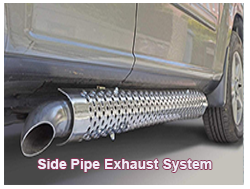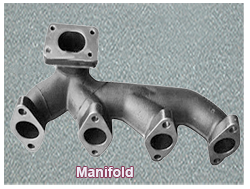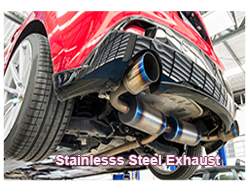
FRONT SILENCER:  Describes the first and main silencer in an exhaust system.
Describes the first and main silencer in an exhaust system.
GULP VALVE: Describes a valve controlled by a vacuum that allows fresh air to enter the inlet manifold during deceleration to prevent the exhaust system from backfiring.
HEADERS: Describes a special exhaust manifold that replaces the stock manifold, characterised by smooth flowing lines that prevent backpressure.
HEAT CROSSOVER: Describes a passage from one exhaust manifold up, over, and under the carburettor and on to the other manifold that is usually found on V-8 or V-6 engines.
HIGH-PERFORMANCE HEADER: Describes an exhaust manifold, custom-designed and produced using curved and welded steel tubes to provide an uninterrupted flow path for the exhaust gases.
MANIFOLD: Describes a single pipe or number of pipes that connect to a series of outlets to form a common opening.
MANIFOLD CONTROL VALVE (MCV): Describes a thermostatically operated valve in the exhaust manifold whose role is to vary heat levels to the intake manifold relating to engine temperature.
MUFFLER: Describes a unit used to quiet the sounds of the running engine through which exhaust gases are passed.
STAINLESS-STEEL EXHAUST SYSTEM: Describes a system that is a hard-wearing alternative to steel although considerably more expensive system.
TWIN PORT: Describes a type of cylinder head design fitted with twin exhaust ports.
PARTICULATE EMISSION: Describes the emission of solid particles usually comprising carbon and unburnt hydrocarbons from the exhaust system.
RESIDUAL EXHAUST GASES: Describes the exhaust gas remaining in a two-stroke engine cylinder after the exhaust ports have been closed.
RESONATOR: Describes a small muffler-like device placed in the exhaust system near the end of the tailpipe that is used to provide additional silencing of the exhaust
SCAVENGING: Describes the procedure of removing exhaust gases from the cylinder by taking advantage of the pressure waves set up in the exhaust pipe by discharging the gases.
SIDE PIPE: Describes an exhaust pipe that runs along the side of the car.
SLIP JOINT: Describes an exhaust pipe connection where one pipe slips into another.
SPLIT MANIFOLD: Describes a form of exhaust manifold with a longitudinal baffle placed near its centre, allowing an exhaust pipe to protrude out of each half.
STRAIGHT-THROUGH SILENCER: Describes an absorption silencer fitted with a single perforated tube surrounded by sound-absorbing fibre, creating less back pressure, thus reducing power loss.
TAILPIPE: Describes the pipe which runs from the exhaust muffler to the rear of the vehicle open to the atmosphere, through which exhaust gases are routed into the atmosphere.
TAILPIPE EXPANDER:  Describes a unique automotive tool used to reshape and expand tailpipes to prevent exhaust leaks.
Describes a unique automotive tool used to reshape and expand tailpipes to prevent exhaust leaks.
TWIN EXHAUST SYSTEM: Describes a type of exhaust system fitted with twin tailpipes that go to form a complete exhaust system in cars powered by V-engines.
Y-PIPE: Describes a Y-shaped downpipe used to connect to a two-branch exhaust manifold to a single exhaust pipe.
UB5


